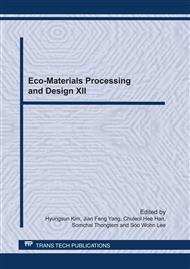p.328
p.332
p.336
p.340
p.344
p.348
p.353
p.357
p.361
Research on the Optimization of Ni/Si Atomic Ratio for Cu-Ni-Si Alloys with High Strength and High Electrical Conductivity
Abstract:
Two sets of Cu-Ni-Si alloys with different Cu contents and Ni/Si atomic ratios were fabricated under the state of near-equilibrium solidification. The microstructures were observed by SEM and phase compositions were identified by XRD. The electrical conductivity and hardness were tested by Eddy-Conductivity Apparatus (ECA) and Digital Rockwell Hardmeter, respectively. The experimental results show that all the researched Cu-Ni-Si alloys are consisted of three phases, i.e. α-Cu(Ni,Si), Ni3Si and δ-Ni2Si. With the increase of Ni/Si atomic ratio, the amount of Ni3Si decreases persistently but that of δ-Ni2Si and electrical conductivity increases firstly and then decreases, the hardness decreases firstly and then increases following by a decrease finally. Both the electrical conductivity and hardness reach a relativity highest value when the Ni/Si atomic ratios are 2.6:1 and 2.4:1 for Cu-Ni-Si alloys with 95wt.% and 90wt.% Cu content respectively.
Info:
Periodical:
Pages:
344-347
Citation:
Online since:
July 2011
Authors:
Price:
Сopyright:
© 2011 Trans Tech Publications Ltd. All Rights Reserved
Share:
Citation:


